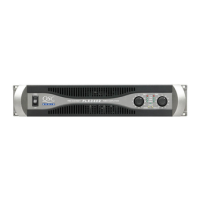Test
&
Calibration
PLX 1202 Test Procedure
.
SET-UP
1.
Connect a test load to the output terminals of the amplifier.
2. Make sure Mode Switches 1
-
10 are in the default position (1 on, 10 on, all others off).
3. Connect a distortion analyzer with a resolution of
O.Ol%,
20-2OkHz
(or better) to the
output terminals of the amplifier. Enable the
8OkHz
low pass filter.
4. Connect a dual-channel oscilloscope to the following test points:
Chl
-
a
IOX
(vertical sensitivity
-
2V/cm)
scope probe to the channel speaker output.
Ch2
-
a IX scope probe (vertical sensitivity
-
O.lV/cm)
to the distortion analyzer
output.
5.
Set amp gain pots fully clockwise and turn on power switch.
6. Connect the output of the signal generator to the input terminals of the amplifier and
select an output of 1.30
VRMS,
1
kHz
sine wave.
7. Plug the amplifier into a variac and set up an AC line current monitor.
. POWER UP 8 MUTE DELAY TEST
CAUTION: To avoid damage to the main printed circuit board, place a
50
ohm
225W
resistor (100 ohm,
240VAC) in series with the high
(+)
lead on the AC cable during variac ramp up. If the switching power
supply has a shorted device at initial power up, this AC resistor pad will help prevent undue damage. After
the amplifier has been fully powered up via the variac, confirm that the amplifier has achieved
stable operation during idle. Remove AC power from the amplifier and disconnect the series
resistor for normal operation. Continue with the test
&
calibration process.
I. Slowly raise the variac voltage and watch for excessive current draw (line current
greater than
0.5A
a.c. at 60 Volts). This is slightly less for 240V.
Pause at
9OVAC
(2OOVAC European) for three seconds until the mute I protect circuit disengages.
Continue to
12OVAC
(240V European).
2. Verify that the fan is operating at low speed.
3. Turn the power switch off and on a few times to verify the 3 second power-up muting
delay.
l CHANNEL OUTPUT
I. Look for amplified signal on the scope for channel
1.
Switch the input signal and scope
to channel 2 and repeat output test. Check for noisy
/
contaminated gain pots by
observing general instability on the distortion waveform while adjusting the gain control
levels.
2. Select an 8 ohm load and confirm that this amplifier is producing 200 watts at 1 kHz just
below the point of clipping. Check both channels.
l BRIDGE MODE
1. Turn the power switch off.
2. Set Mode Switch
#7
in the on position. The gain control, limiter, and filter switch positions
on CH2 are disabled with Mode Switch
#7
on.
3.
Set load to both red output binding posts
(CHI
positive and CH2 negative).
4. Apply a 1.30
VRMS,
1
kHz
sinewave input to channel I of the amplifier. Check the power
and verify that the output does not immediately collapse. Check for 700 watts at 8 ohms.

